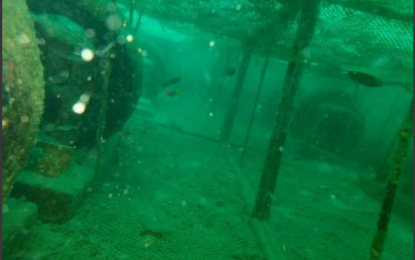
LOBSTER BREEDING. Tiger Lobster and Bamboo Lobster species are being bred in underwater cages at Sagay Marine Reserve off Sagay City, Negros Occidental in this recent photo. The project aims to replenish lobster stock in Negros Island under the principle of sustainable fisheries and marine conservation. (Photo courtesy of Sagay City Information and Tourism Office)
BACOLOD CITY – Two rare varieties of lobsters are being bred in underwater cages at the Sagay Marine Reserve, the country's largest marine protected area, to boost lobster population in Negros Island.
These are the Tiger Lobster (Panulirus Ornatus), considered the most premium and with the highest quality breed, and the Bamboo Lobster (Panulirus Versicolor).
The project, spearheaded by the Sagay City Environment and Natural Resources Office (SCENRO) in Negros Occidental, places lobster breeders in an open-type cage system submerged at sea, allowing them to have a conducive environment for spawning while maintaining their natural habitat.
As of Monday, the SCENRO has already released three female and two male spawns of bamboo lobster breeders, each weighing 1.7 kilograms, as well as two female and a male tiger lobster breeder spawns, with a weight of two kilograms each.
“We are pursuing environmental sustainability while helping the local economy by enhancing rare lobster stock in the Sagay Marine Reserve,” SCENRO head Mayo Antonio Cueva said in a statement.
He added that they are now observing the survival rate of the released lobster eggs.
Cueva said he hopes for the project’s success, noting that for every 50,000 eggs produced during the post-larval stage, only about two lobsters are expected to survive to legal size.
In a separate statement, Second District Rep. Alfredo Marañon III, chairperson of the House Committee on Aquaculture and Fisheries Resources, and a former mayor of Sagay City, said the project supports their vision of sustainable fisheries and marine conservation and is seen to serve as a model for other coastal communities in promoting responsible aquaculture practices.
“The initiative is commendable for its proactive approach in addressing the decline of rare lobster species,” he added. (PNA)
